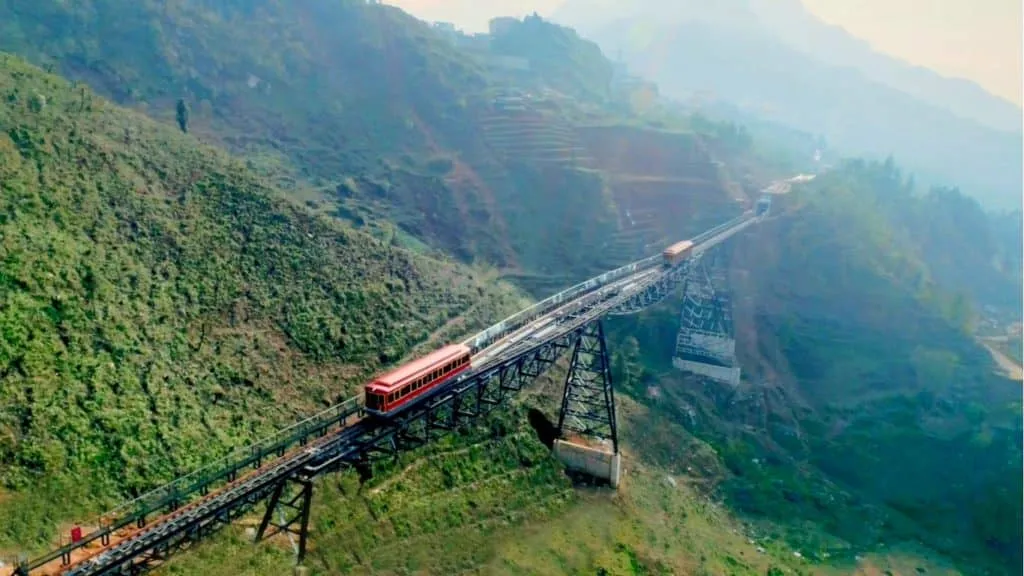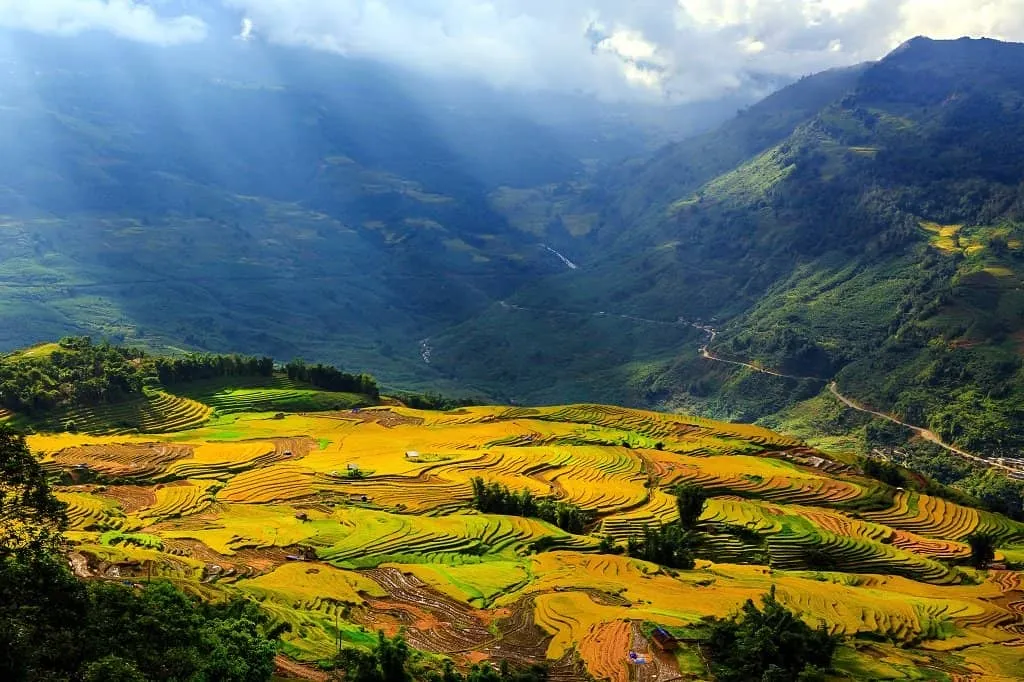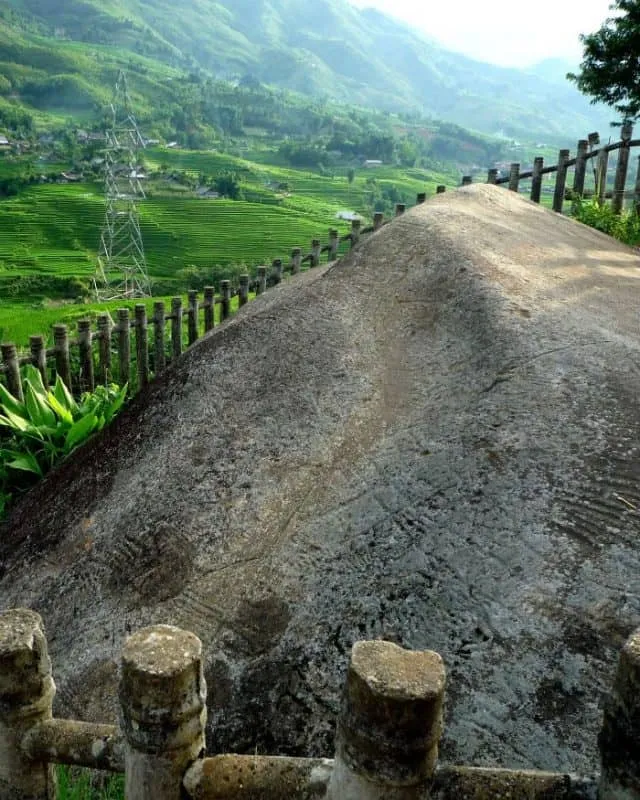Stepping into Sapa, visitors feel transported to another world, where rolling mountains hide in the misty air, and especially, Muong Hoa Valley emerges like a stunning watercolor painting. This valley is not just a tourist destination, but a living work of art, created by the harmonious blend of skillful human hands and the magnificent beauty of Northwest Vietnam’s nature. Muong Hoa offers everyone a strangely peaceful feeling, an ideal haven to escape the hustle and bustle of daily life.
Journey to Muong Hoa Valley: An Exploration
Located approximately 8km southeast of Sapa town center, Muong Hoa Valley belongs to Hau Thao commune, one of Sapa’s precious tourism gems. The journey to Muong Hoa Valley is not just a trip, but a memorable experience as you conquer winding mountain passes along high slopes. The road may challenge your driving skills, but the reward is the majestic natural scenery unfolding before your eyes, worth every effort.
To reach the valley, you can choose from various means of transportation. If you are a lover of freedom and exploration, a motorbike is an excellent choice. You can rent a motorbike in Sapa and conquer the road to Muong Hoa yourself. On the way, don’t forget to stop at scenic viewpoints to admire the scenery and take photos. However, please note that the road has many steep and winding sections, so ensure you have steady driving skills and are fully equipped with traffic safety knowledge.
Alternatively, you can choose to take a taxi or motorbike taxi (xe om) if you want a comfortable trip without worrying about driving. Motorbike taxis are a popular means of transport in Sapa and surrounding areas, and the drivers are usually very knowledgeable about the routes and can take you to the valley safely and quickly. Taxis are also a convenient option, especially if you are traveling in a group or with family.
In recent years, to serve the increasing demand for visiting Muong Hoa Valley, the Muong Hoa mountain railway line has been put into operation. This is a unique and exciting experience that allows you to admire the panoramic view of the valley from above easily and comfortably. The train will take you through steep sections, through lush pine forests, and reveal a stunning panoramic view of Muong Hoa Valley before your eyes. Sitting on the train, you can relax, enjoy the scenery, and breathe in the fresh air of the Northwest mountains and forests.

Whichever transportation you choose, the journey to Muong Hoa Valley will surely be an indispensable part of your Sapa trip. This is not just a road leading to a beautiful destination, but also an opportunity for you to explore and experience the diverse beauty of Northwest Vietnam’s mountains and forests.
The Heart-stirring Beauty of Muong Hoa Valley
Muong Hoa Valley is famous for two distinctive beauties: the vast terraced rice fields and the mysterious Sapa ancient rock field. The harmonious combination of magnificent natural landscapes and unique historical and cultural imprints has created a special attraction for this valley.
Muong Hoa Terraced Fields: Masterpieces of Nature and Humanity
Sapa is known as the land of terraced fields, and Muong Hoa Valley is where the most beautiful and largest terraced fields converge. When you arrive here, you will be amazed by the majestic beauty of the soft, winding terraced fields, embracing the hillsides, creating a unique sloping bowl shape.
The beauty of Muong Hoa terraced fields changes with the seasons, bringing different experiences for visitors. In spring, when the light drizzle begins to fall, local people start to lead water into the fields, preparing for a new crop. At this time, the terraced fields are like giant mirrors reflecting the blue sky, creating a shimmering, magical scene.
In summer, when the rice begins to grow, the entire valley is covered in a lush green color. The terraced fields are like a soft green silk strip winding through nature, bringing a feeling of peace and relaxation. This is also an ideal time for you to take trekking trips to explore the valley, immersing yourself in the green space of the rice fields.

In autumn, Muong Hoa Valley puts on the golden coat of ripe rice. The entire valley seems to light up the sky, the fragrant aroma of rice spreads in the air, creating a romantic and captivating scene. This is the most favorite time for many tourists because you can admire the brilliant beauty of the golden season and capture beautiful photos.
In winter, Muong Hoa Valley takes on a deep and quiet beauty. Sometimes, you may be lucky enough to see snow falling, covering the terraced fields in white, creating a romantic scene like Europe. However, winter in Sapa is quite cold, so if you come at this time, please prepare warm clothes and learn about the weather conditions carefully.

Muong Hoa terraced fields are not only a beautiful natural landscape but also a symbol of the diligence, creativity, and solidarity of the ethnic minorities here. To create these terraced fields, they have had to sweat, put in effort, and go through many generations. Terraced fields are not only places to grow rice but also a source of life, culture, and pride of the Muong Hoa people.
Sapa Ancient Rock Field: Mystery Challenging Time
Besides the terraced fields, Muong Hoa Valley is also famous for the Sapa ancient rock field, a unique and mysterious cultural heritage. This ancient rock field was discovered in the early 20th century and covers an area of about 8km2, with nearly 200 large and small rocks scattered throughout the valley.
The most special and attractive feature of the Sapa ancient rock field for tourists is the carvings on the rocks. On sandstone slabs, ancient people carved unique patterns and drawings, reflecting the culture, beliefs, and life of prehistoric people. Researchers have found drawings of terraced fields, human figures, stilt houses, animals, roads, writings, and even incomprehensible shapes with many mysterious meanings on the rocks.

The origin and meaning of the carvings on the rocks are still a mystery to scientists and tourists. Many theories have been put forward, but none have been proven to be completely accurate. Some believe that these are works of art by prehistoric people, while others believe that these are symbols with spiritual and religious meanings. Whatever the true meaning, the Sapa ancient rock field is still an attractive destination, arousing curiosity and exploration from visitors.
When you come to the Sapa ancient rock field, you not only admire the strange rocks but also immerse yourself in a unique historical and cultural space. You can walk along the trails, explore each rock, learn about the carvings, and listen to stories and legends about the ancient rock field. This is an interesting and informative experience that helps you understand more about the history and culture of Sapa.
Hoa Stream: A Soft Silk Ribbon in the Valley
It is impossible not to mention Hoa Stream, an indispensable part of the beauty of Muong Hoa Valley. This stream stretches for about 15km along the valley, winding softly like a silk ribbon, embracing the terraced fields and peaceful villages.
Hoa Stream originates from high mountains, flows through Lao Chai, Ta Van, Hau Thao communes, and ends in Ban Ho village. The clear, cool water of Hoa Stream not only provides a source of life for people and plants in the valley but also creates a poetic and lyrical natural landscape.
In the ripe rice season, when the golden color of rice fields is reflected in the clear blue water, Hoa Stream becomes more shimmering and magical than ever. Sunlight shines on the water surface, creating sparkling streaks of light, reflecting both the blue sky and white clouds. This scene will surely captivate you and make you not want to leave.
Along Hoa Stream, you can find many ideal stops to relax and enjoy the scenery. You can sit on the rocks by the stream, listen to the sound of water flowing, admire the green or golden terraced fields, and enjoy the fresh air of the mountains and forests.
Complete Muong Hoa Valley Travel Experience
To have a complete and memorable trip to Muong Hoa Valley, you should learn carefully about the ideal time, accommodation options, cuisine, and experiential activities here.
Ideal Time: When is Muong Hoa Valley Most Beautiful?
Muong Hoa Valley has its own beauty in each season, and the ideal time to travel depends on your preferences and desired experiences.
- March to May: Sapa weather during this period is very pleasant, cool, neither too hot nor too cold. This is an ideal time for you to explore the valley, trek, and visit other tourist attractions in Sapa. The terraced fields in this season are covered with a fresh green color, very suitable for those who love the fresh beauty of nature.
- September to November: This is the rice harvest season in Sapa, and also the most favorite time for many tourists. The entire Muong Hoa Valley seems to be dressed in a brilliant golden coat, creating a romantic and captivating scene. If you want to admire the golden season beauty of terraced fields, then this is a time not to be missed.
- December to February: Winter in Sapa is quite cold but brings a unique and different beauty. If you are lucky, you can see snow falling on Muong Hoa Valley, a rare and memorable experience. In addition, during the Lunar New Year (Tet), you also have the opportunity to participate in traditional festivals and explore the unique culture of the ethnic minorities here.
Accommodation and Cuisine: Local Experiences
To fully experience the beauty and culture of Muong Hoa Valley, you should choose to stay at homestays in the villages. Homestays are usually built in the traditional style of ethnic minorities, providing a cozy space close to nature. You can find many beautiful and quality homestays in Lao Chai, Ta Van, and Hau Thao villages.
Regarding cuisine, Muong Hoa Valley also has many attractive specialties that you should try. The dishes are prepared from fresh local ingredients, imbued with the flavors of the Northwest mountains and forests. Some famous dishes you should not miss include: Thang Co (horse meat stew), Thit Trau Gac Bep (smoked buffalo meat), Lon Cap Nach (armpit-carried pig), black chicken, Xoi Bay Mau (seven-colored sticky rice), and typical Sapa vegetables.
Activities and Experiences: Exploring Muong Hoa
In addition to sightseeing and exploring terraced fields, ancient rock fields, and Hoa Stream, you can also participate in many other exciting experiential activities at Muong Hoa Valley.
- Trekking: Muong Hoa Valley has many beautiful and attractive trekking routes, suitable for many types of tourists. You can choose short or long day hiking trails, exploring villages, terraced fields, waterfalls, and mountains.
- Cultural Exploration: Coming to Muong Hoa Valley, you have the opportunity to learn about the unique culture of ethnic minorities such as H’Mong, Red Dao, and Giay. You can visit villages, talk to local people, learn about customs and traditions, traditional crafts, and enjoy folk art performances.
- Photography: Muong Hoa Valley is a paradise for photography enthusiasts. With diverse and rich natural landscapes, you can unleash your creativity and capture the most beautiful moments of the valley.
Conclusion: Muong Hoa Valley – An Unmissable Destination in Sapa
Muong Hoa Valley is not just a tourist destination, but also a unique cultural and natural experience. With the majestic beauty of terraced fields, the mystery of the ancient rock field, and the poetic charm of Hoa Stream, this valley deserves to be one of the unmissable destinations when you come to Sapa. Take your time to explore and feel the beauty of Muong Hoa Valley, you will surely have memorable memories and wonderful experiences.